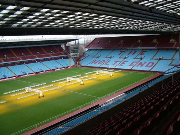 Since 2001, Villa Park, home to Premier League football Club, Aston Villa, has utilised a building energy management system (BEMS) from Trend Controls, when one was installed at the ground’s Trinity Road Stand.
Since 2001, Villa Park, home to Premier League football Club, Aston Villa, has utilised a building energy management system (BEMS) from Trend Controls, when one was installed at the ground’s Trinity Road Stand.
Since that time the Trend BEMS has expanded into other areas of the ground in order to enhance energy efficiency and save costs.
Based in Witton, Birmingham, the club, nicknamed the Villains, has played at its home ground since 1897. With a seating capacity of 42,786, split between four stands, it is one of largest football stadiums in the country and also houses a number of administrative and hospitality areas.
The BEMS system allows the stadium’s maintenance manager, Josh Tooth, to quickly and easily adjust the setpoints of its facilities to suit the specific requirements of each type of event taking place. He explained, “The BEMS is used primarily for the control of heating, ventilation and air conditioning (HVAC), as well as lighting. It is also used at The Holte – the club’s own pub next to Villa Park – and the training ground located ten miles away near Tamworth. These are connected through Ethernet links, which means that all the locations can be monitored and controlled at once.”
In order to have 24/7 access to all the energy usage data supplied by the BEMS, and to make adjustments where necessary, a Trend Controls 963 Supervisor has been installed. This is a graphical, real time user interface that acts as a window to the BEMS and is connected via a local area network. A standard web browser allows users to directly interface with the software through a variety of devices.
At the beginning of each week Tooth looks at the schedule of events and configures the BEMS so that facilities activate automatically as required.
Although the schedule can change at short notice he can make alterations from any remote location – whether at home or at work – via his PC or by accessing the 963 Supervisor via his smartphone or tablet using standard Internet Explorer tools.
“There are many instances where being able to control the BEMS remotely has massive benefits,” Tooth commented. “For example, lots of our games are televised across the world and outside broadcasting teams often arrive in the middle of the night to begin setting-up. Rather than having to travel to the ground to activate the plant for them, I can do it from home. Not only is this highly convenient, it also does wonders for my sleep pattern.”
In the event of a system malfunction, or the activation of critical alarms due to a boiler, gas valve or ventilation fan failure, a text message will be sent to his smartphone detailing the problem. He can then adjust the plant and, if necessary, initiate back-up equipment. Additionally, an override switch has been installed which assists maintenance engineers in locating problems by turning the entire system on. Once the problem is rectified it is simply switched back again to the pre-programmed settings.
With the majority of the football season taking place during the winter months, Villa Park has an under pitch heating system so that games can go ahead whatever the weather. This too can be controlled remotely or via the temperature sensors that have been installed in the soil and linked to the system. Also, because a game could have to be postponed if the stadium’s outstation was to malfunction and fail to activate the under pitch heating, a back-up outstation has been configured with the same strategy pre-loaded on it.
The Trend BEMS also plays a vital role in achieving energy reductions and lowering carbon emissions at the site, helping Aston Villa to meet is Corporate Social Responsibility objectives. Tooth stated, ‘The concourse lighting used to be on throughout the day and night, even when there was no-one present. Now the BEMS switches low energy LED luminaires on at certain times, while later in the night it switches the system off completely. We have also installed light sensors that can identify lux levels and if they are over a specified figure the lighting does not switch on.”
Many of the stadium’s supply and extract fans have been fitted with Trend Controls’ variable speed drives, enabling the BEMS to adjust fan speeds automatically, optimising their efficiency and providing considerable energy savings. CO2 sensors have also been installed in some rooms and the air conditioning fans are ramped up if the air quality falls below a specified point.
For Villa Park, the development of its BEMS is an ongoing project, as Tooth concluded, “I’m delighted with what we have achieved with it so far but we are always looking for new ways to enhance our operations and make energy savings. Our next project is to integrate the car park lighting, where we believe we could set the system to switch off the lights for up to four hours a day.”


